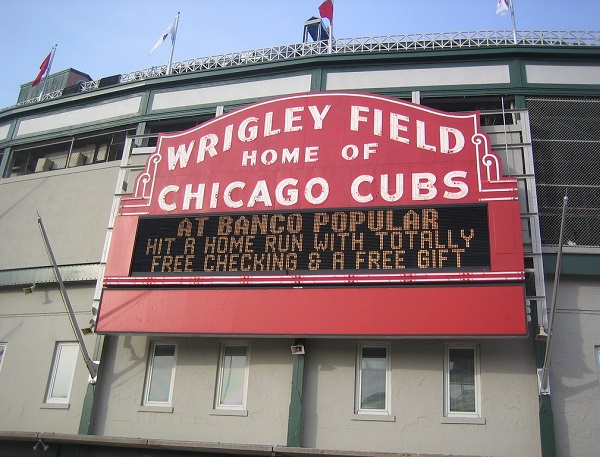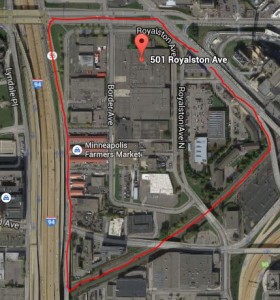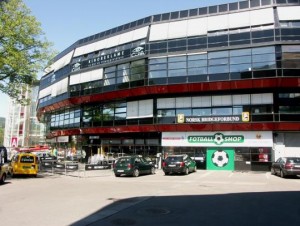This article was originally published on Streets.mn.
When I was a junior in college, I studied abroad in Oslo, Norway. I lived in a student housing village a distance away from campus, nearer to the vast woods in the city’s backyard than to the bustling center. The closest landmark to my flat was Ullevål Stadion, the national stadium and home to Vålerenga IF, the local Tippeligaen side. I walked past the stadium every day when traveling to and from it’s eponymous T-Bane stop, where I rode the metro to school. On gamedays with the window open you could hear the roar of the crowd when a goal was scored.
I’ve been thinking a lot about Ullevål in particular, and stadiums in general in the past week, after our local soccer team, Minnesota United FC released their funding plan for a downtown soccer stadium near the farmers market. As both a card carrying member of the team’s supporters group and an advocate for urban amenities, I would love the proposal to come to fruition. And I believe ultimately it will. But the United proposal has been tied up in political debates about public subsidy. The team plans to buy the land and build the stadium privately, but requested the same tax relief granted to the Vikings and Twins stadiums. Most significantly, this would mean exempting the team from having to pay property taxes on the stadium.
The property tax break would total between $1.5 – $3 million a year, depending on whose estimate you trust. Given the obscene amounts of cash the state, county, and city have splashed on other stadium projects, (or, say, a pedestrian bridge) it’s absurd that politicians have decided to stand firm in refusing a pocket change subsidy for a soccer stadium. Yet complaining about the audacious cynicism of politicians is as useless as complaining about Minnesota’s April weather. It’s also not an affirmative argument for anything. The deal offered by Minnesota United may well be the best stadium deal the state has seen in decades. But does that make it a good deal?
Reviewing arguments against stadium subsidies
Yesterday, I published an interview with Neil deMause, a journalist who covers the topic of public stadium subsidies on his blog Field of Schemes. Unencumbered by Minnesota political concerns, Neil makes a compelling case that public subsidies for stadiums of any stripe are a waste of money for government. Much of what he says is known among sports fans, but it’s worth repeating here:
From an economic standpoint, stadiums do not generate much new activity; stadium jobs are seasonal and low paying, and they compete for entertainment dollars from locals instead of attracting visitors from other places.
From an urban planning standpoint, stadiums are poor development anchors, as they remain unused for most of the year and have huge ancillary requirements; especially parking.
Then there are the trade offs. Stadiums tend to be built on disused industrial land, bringing with them the promise of development. But would that development have occurred otherwise? That question could fairly be asked about the new Vikings stadium, which has been intrinsically linked to the Ryan Co. Wells Fargo development. But are the new offices and apartments really being built because they derive value from the Vikings Stadium? If not, then might it be fair to say that something like it would’ve been built anyway? And if that is true, then why are we wasting a huge block of soon-to-develop downtown land on a tax-exempt stadium that will be used to capacity 8-10 times a year?
These are tough but necessary questions to answer for anyone who supports this soccer stadium development. To address them, it’s important to make a comprehensive case about why this stadium could be different. We already know it’s a much better deal financially than normal. But it’s also important for the stadium design to sell itself. Few stadiums are created equal. Wrigley Field is the heart of a vibrant neighborhood, and a stadium like Wrigley would be well worth subsidy. Meanwhile Tropicana Field in Tampa is an aesthetic and developmental disaster that you’d hope wouldn’t be allowed even if privately funded. So the two key questions are: what could a Minneapolis soccer stadium provide in terms of development that wouldn’t occur otherwise? And how best to design the project to reach those aims?
A Master Plan For A Neglected Neighborhood
One of the key aspects of the soccer stadium debate surrounds its likely location. In this sense, the United proposal shares much in common with those that came before. Target Field was planned for the underdeveloped North Loop. TCF Bank Stadium was planned for the moonscape east of the University that could boast only an Arby’s. The Saint Paul Saints’ CHS Field replaced the miserable Diamond Products/Gillette building that had stood athwart any eastward expansion of Lowertown. Finally, the new Vikings Stadium will replace the Metrodome in windswept Downtown East. In each of these cases, stadiums have targeted underused industrial land, and have usually been packaged with promises to spur development in these areas. It’s hard to say for sure if it’s all worked, but the North Loop is now rapidly filling in around its ballpark, while the Green Line-fueled new urbanism on Washington Avenue is creeping towards the Gophers Stadium.
Minnesota United FC’s proposed home is in a corner of downtown that is increasingly being called the west loop. This part of town is notable only for the Minneapolis Farmers Market with the rest of the land occupied by low slung industrial buildings. It’s unsurprising that the area is so neglected. It is bounded to the west by I94, to the north by Olson Memorial Highway, to the east by the seven-lane-wide 7th Street, and to the south by the rail lines. However, the proposed Royalston Station of the Green Line extension will soon provide direct access to the area, and stadium plan critics, such as Mayor Betsy Hodges, have argued that the nearby plots will be ripe for transit oriented development (TOD) in the near future, stadium or no stadium.
I’m less confident. Despite the appearance of transit over a decade ago, Downtown East has not developed much. The Blue Line-enhanced intersection of Lake and Hiawatha, surely a prime location for TOD, remained undeveloped for a decade as well. This is because the presence of transit alone is not enough to spur TOD growth, locations must also have amenities to offer. Why should developers invest in the barren west loop when better opportunities exist in downtown east, along University Avenue, and in leafier districts along the Green Line extension?
This where stadium proponents must make their case. In addition to building the stadium, Minnesota United FC has committed to an as yet unspecified plan to renovate and improve the farmers market. The plan is not to place a stadium down, free of context, but to build a stadium into the area’s fabric (such as it is) and to actively improve the district’s main existing amenity. Remember that from the very beginning, this has always been the plan.
The stadium plan could (and should, I think) also include a commitment to build at least some TOD immediately. Among the United ownership group is the Pohlad Family, who own the Twins and United Properties. A promise to develop nearby mixed use apartments to compliment both the stadium and the farmers market would improve the offer significantly. All of this would turn the stadium plan from just a stadium plan to a neighborhood plan. The idea of packaging a village into a stadium plan isn’t a unique idea, in fact it’s something of a trend, But what United have the ability to propose is better than the plans considered in other cities, thanks to the presence of transit, the farmers market, and a major local real estate developer already in the conversation.
A Mixed Use Stadium
A stadium plan that doubles as a neighborhood master plan could solve issues stemming from the often late and inadequate development response to stadium constriction. But it doesn’t eliminate the problem inherent in stadiums: they take up a lot of space and are rarely used. Here, I come back to my experiences in Norway.
Ullevål Stadion is not built in a dense city center, nor does it have a neighborhood around it. In fact, it’s hemmed in by a highway, a traffic circle, and the metro line. But I think its design nonetheless offers a compelling model for a stadium that can actually be a spur to development and an asset to the neighborhood it serves.
What distinguishes Ullevål, at least to my knowledge, is that it is a mixed use stadium. Aside from hosting domestic and international soccer matches, the building is home to a hotel, the national football museum, and the offices of the Norwegian Football Association, the Norwegian Olympic Committee, and several other national sports organizations. That’s not all. The exterior of the stadium is lined with year-round restaurants and shops—[url=https://amylamsg.files.wordpress.com/2011/09/florist.jpg]even a florist[/url]. I frequently stopped by Ullevål’s ICA supermarket because they carried pints of Ben and Jerry’s, which were an essential food item as the Nordic winter settled in.
Ullevål’s model addresses one of the key reasons why local stadiums tend to be anchors around the necks of neighborhoods instead of anchors that bind it together. Stadiums are almost never built for any use besides gameday or special events and concerts. But why should that be the case? Ullevål shows us that it can be done in a different way.
Minnesota United FC should take notice. The stadium will be bounded by streets that would be the lifeblood of a new neighborhood. The key one is Royalston Avenue, which will soon have the Green Line LRT running down its heart. The soccer stadium should take advantage of this by using the ground floor of the stadium facing Royalston as retail space. It’s not hard to think of likely tenants: a soccer bar, a sporting goods store, a bottle shop, a gym. But Ullevål’s model tells us that the space should be calibrated to accept whomever is interested, including tenants that might have no connection to sports. Perhaps a gardening supply store might see a benefit to close proximity to the farmers market. Or an upscale restaurant like Saint Paul’s Heartland. And of course, a supermarket that compliments the farmers market would be a tremendous benefit for a neighborhood isolated from the the Gateway District Whole Foods and the Loring Park Lunds. Surely there’s space under the stands for even something as large as that?
Setting A New Standard
There’s no doubt that Minnesota United FC is being held to a much higher standard than any other professional sports stadium built in the Twin Cities. I suspect that’s largely because politicians think (probably rightly) that they can score points by taking a principled approach soccer, a sport that cannot yet boast the constituency of pro football, to whom they capitulated.
That’s unfair, but it also means that United has an opportunity to set a new standard by which stadium deals will be judged. Overall, that might be a good thing for the Twin Cities and municipalities across the United States. The ownership group for Minnesota United is wealthy, but it’s also local. The principal owner, Dr. Bill McGuire, has shown himself to be philanthropic and civic minded in the pas



Leave a Reply